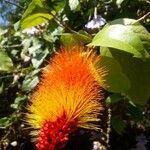Woody liana to 30 m (usually much less), stem up to 18 cm diam., in the absence of support a shrub with scandent or procumbent long branches or a shrub 1-5 m; ‘combretaceous hairs’ (often very scarce) and peltate scales present. Leaves opposite, chartaceous or subcoriaceous, elliptic or sometimes elliptic-oblong to narrowly so, 3.5-19 x 1.5-10 cm, apex usually shortly to long acuminate but sometimes acute or obtuse, base cuneate to rounded or subcordate, often hairless or almost so but sometimes pubescent or even densely so below and sparsely so above, moderately to rather densely yellowish-or golden-lepidote below, sparsely or very sparsely so above; venation usually eucamptodromous-brochidodromous, sometimes eucamptodromous or brochidodromous, secondary veins (5-)6-9(-10) pairs; petiole 0.6-1.5 cm long, glabrous to densely pubescent, contiguously to moderately yellow-to golden-lepidote. Inflorescence unbranched, stout, in opposite pairs in leaf-axils, 4-15 cm long, usually aggregated into terminal racemes up to 25(-40) cm long, at lower nodes in axils of normal leaves (usually fallen by fruiting), at upper nodes usually without or with much reduced subtending leaves, glabrous to rather densely pubescent, densely to contiguously golden-lepidote; flowers borne densely around rhachis but in nature all swept up to vertical position from ± horizontal rhachis, with long exserted stamens forming 'bottle-brush' syndrome. Flowers 4-merous, variable in size and shape, 10.5-17(-20) mm long, varying fromglabrous to rufous-pubescent on outside; lower hypanthium 3.5-4.5(-6.5) mm long, 4-angled, pedicel-like region 0.5-1.7 mm long, contiguously golden-lepidote, upper hypanthium 6-12.5(-13.5) x 4-6(-12.5) mm, with narrowly infundibuliform region below disk, 1.5-4.5(-5) mm long and abruptly demarcated deeply cupuliform region above disk, 3-6(-7.5) mm long excl. calyx lobes, moderately to densely golden-lepidote, often shortly pubescent on inside even when hairless outside; calyx lobes erect, 1.3-2.3(-3) mm long, apex acute to subacute or sometimes obtuse and apiculate, moderately to densely golden-lepidote; petals 4, very rarely absent, elliptic to suborbicular, 1.5-2.5(-3.2) x 0.8-1.5(-2) mm, usually shorter than calyx lobes but sometimes reaching about to their apex, apex obtuse to acute, sometimes apiculate or shortly acuminate, without a basal claw, glabrous, rarely sparsely lepidote outside; stamens 8, far exserted, filaments 12.5-22 mm long; disk densely pubescent at margin with straight or wavy hairs, distinct free margin 0.2-1 mm long; style 13-31.5 mm long, exserted about as far as stamens. Fruit often vinous-red, moderately to densely golden-lepidote especially on body, 1.2-3 x 1-2.9 cm, oblong-elliptic or elliptic to very broadly so, apex obtuse to rounded or retuse and usually distinctly apiculate, base rounded to truncate or slightly retuse with very distinct narrow pseudostipe 0.1-0.55 cm long, wings 4, 0.4-0.9 cm wide. Scales ca. 70-200 µm diam., marginal cells ca. 35-70.
More
Shrub of 3-8 m. or liana, branchlets somewhat quadrangular, scaly at first but otherwise glabrous (in Panama specimens). Leaves papyraceous or chartaceous, opposite, petiolate; petioles scaly, 7-10 mm. long; lamina elliptic to broadly elliptic, 5-12 X 3-7 cm., minutely verruculose above, conspicuously scaly beneath, scales usually golden or golden-brown, occasionally reddish, dense but scarcely marginally contiguous, usually glabrous or nearly so in Panama but variously hairy in other regions, rather bluntly acuminate at the apex, cuneate or rounded at the base. Flowers yellow or greenish-yellow, 4-merous, sessile or subsessile in terminal panicles of spikes and lateral spikes, rhachis scaly. Lower receptacle (ovary) quadrangular, 2-3 mm. long, densely scaly; upper receptacle clearly differentiated into two parts, a lower narrowly infundibuliform part containing the disk and an upper broadly infundibuliform or campanulate part terminating in the calyx-lobes, measuring about 7-8 mm. from the apex of the ovary to the tips of the calyx-lobes, with conspicuous golden or golden-brown (rarely reddish) scales otherwise nearly glabrous (in Panama). Calyx-lobes broadly ovate, about 2 mm. long. Petals yellow, usually glabrous, very variable in size and shape but usually not more than 1-1.5 mm. long, shorter than the calyx-lobes. Stamens 8, filaments 15-20 mm. long, anthers about 1 mm. long. Disk infundibuliform with a pilose margin. Style 15-20 mm. long, glabrous. Fruit subspherical in outline, 14-18 mm. in diameter, reddish-brown or purple, with 4 flexible wings about 6 mm. wide, scaly, shortly stipitate.

